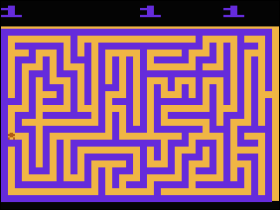
 The Game: The goal of the game is simple: race through a twisty maze and beat your opponent to the exit. Some game variations adds randomly moving “robbers” to the maze, in some cases as prey and in other cases as hunters to be avoided. (Atari, 1980)
The Game: The goal of the game is simple: race through a twisty maze and beat your opponent to the exit. Some game variations adds randomly moving “robbers” to the maze, in some cases as prey and in other cases as hunters to be avoided. (Atari, 1980)
Memories: A fairly recent transplant from Fairchild, programmer Rick Maurer’s first game for the Atari VCS was pretty familiar to anyone who had been playing games on the Fairchild Channel F: it was essentially a port of the Channel F’s Maze game on the Atari console. Like its forebear, Maze Craze is a marvelously compact piece of coding, packed into a mere 2K. Like so many early titles for the 2600, it’s a lot of fun with the right crowd.

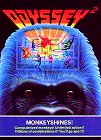 The Game: An elaborate game of tag, only the simian players have an advantage; human players, when tagged, must be “un-tagged” by the other player to return to the game. (Magnavox, 1980)
The Game: An elaborate game of tag, only the simian players have an advantage; human players, when tagged, must be “un-tagged” by the other player to return to the game. (Magnavox, 1980) The Game: In the opening screen – the mists of time, so the rulebook tells us – two players pick their characters’ classes. Warriors are sword-wielding strongmen, wizards can cast spells from a distance, phantoms can walk through solid walls (but not lava formations), and changelings can become invisible when they move. The two intrepid adventurers then set forth on a quest to retrieve the ten rings of power from randomly selected dungeons and filled with randomly selected horrors. (Magnavox, 1980)
The Game: In the opening screen – the mists of time, so the rulebook tells us – two players pick their characters’ classes. Warriors are sword-wielding strongmen, wizards can cast spells from a distance, phantoms can walk through solid walls (but not lava formations), and changelings can become invisible when they move. The two intrepid adventurers then set forth on a quest to retrieve the ten rings of power from randomly selected dungeons and filled with randomly selected horrors. (Magnavox, 1980)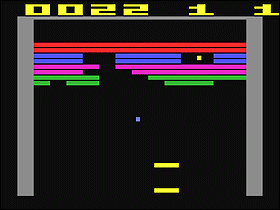
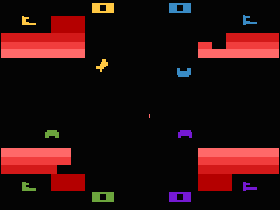
 The Game: You start the game by creating a character, Basic D&D style, who enters the world defenseless and just this side of naked. It’s your job to arm and armor your alter-ego, buy plenty of rations, and then set out to explore the world of Britannia, and the treacherous dungeons that lie beneath it. A visit to the castle of Lord British will give you a chance to level up for deeds accomplished, and receive an assignment from him for your next adventure. (California Pacific Computer, 1980)
The Game: You start the game by creating a character, Basic D&D style, who enters the world defenseless and just this side of naked. It’s your job to arm and armor your alter-ego, buy plenty of rations, and then set out to explore the world of Britannia, and the treacherous dungeons that lie beneath it. A visit to the castle of Lord British will give you a chance to level up for deeds accomplished, and receive an assignment from him for your next adventure. (California Pacific Computer, 1980)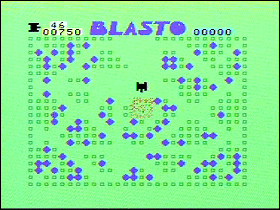 The Game: Piloting your mobile cannon around a cluttered playfield, you have but one task: clear the screen of mines, without blowing yourself up, in the time allotted. If you don’t clear the screen, or manage to detonate a mine so close to yourself that it takes you out, the game is over. If you do clear all the mines, you get a free chance to try it again. Two players can also try to clear the minefield simultaneously. (Texas Instruments, 1980)
The Game: Piloting your mobile cannon around a cluttered playfield, you have but one task: clear the screen of mines, without blowing yourself up, in the time allotted. If you don’t clear the screen, or manage to detonate a mine so close to yourself that it takes you out, the game is over. If you do clear all the mines, you get a free chance to try it again. Two players can also try to clear the minefield simultaneously. (Texas Instruments, 1980)
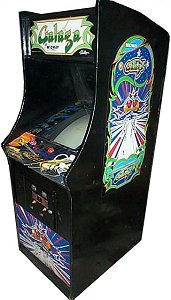
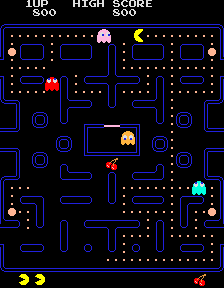 The Game: As a round yellow creature consisting of a mouth and nothing else, you maneuver around a relatively simple maze, gobbling small dots (10 points) and evading four colorful monsters who can eat you on contact. In four corners of the screen, large flashing dots (50 points) enable you to turn the tables and eat the monsters for a brief period for an escalating score (200, 400, 800 and 1600 points). Periodically, assorted items appear near the center of the maze, and you can consume these for additional points as well. The monsters, once eaten, return to their home base in ghost form and return to chase you anew. If cleared of dots, the maze refills and the game starts again, but just a little bit faster… (Nittoh, 1981)
The Game: As a round yellow creature consisting of a mouth and nothing else, you maneuver around a relatively simple maze, gobbling small dots (10 points) and evading four colorful monsters who can eat you on contact. In four corners of the screen, large flashing dots (50 points) enable you to turn the tables and eat the monsters for a brief period for an escalating score (200, 400, 800 and 1600 points). Periodically, assorted items appear near the center of the maze, and you can consume these for additional points as well. The monsters, once eaten, return to their home base in ghost form and return to chase you anew. If cleared of dots, the maze refills and the game starts again, but just a little bit faster… (Nittoh, 1981)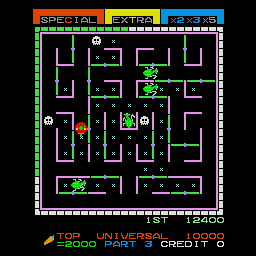 The Game: You control a nice, big, juicy ladybug waddling around a complex maze, gobbling up food and avoiding your nasty fellow insects. Doors in the maze can throw pursuers off your track momentarily – or they can trap you into an even worse situation than whatever you’re trying to escape. (Universal, 1981)
The Game: You control a nice, big, juicy ladybug waddling around a complex maze, gobbling up food and avoiding your nasty fellow insects. Doors in the maze can throw pursuers off your track momentarily – or they can trap you into an even worse situation than whatever you’re trying to escape. (Universal, 1981)
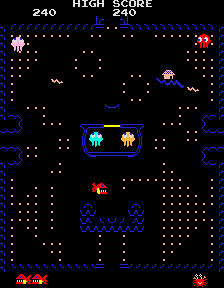 The Game: As a butt-ugly fish, you maneuver around a simple undersea maze, gobbling small dots (10 points) and evading four colorful squids who can eat you on contact. In four corners of the screen, large flashing dots (50 points) enable you to turn the tables and eat the monsters for a brief period for an escalating score (200, 400, 800 and 1600 points). Periodically, assorted items appear near the center of the maze, and you can consume these for additional points as well. The squids, once eaten, return to their home base in ghost form and return to chase you anew. If cleared of dots, the maze refills and the game starts again, but just a little bit faster… (“GL”, 1981)
The Game: As a butt-ugly fish, you maneuver around a simple undersea maze, gobbling small dots (10 points) and evading four colorful squids who can eat you on contact. In four corners of the screen, large flashing dots (50 points) enable you to turn the tables and eat the monsters for a brief period for an escalating score (200, 400, 800 and 1600 points). Periodically, assorted items appear near the center of the maze, and you can consume these for additional points as well. The squids, once eaten, return to their home base in ghost form and return to chase you anew. If cleared of dots, the maze refills and the game starts again, but just a little bit faster… (“GL”, 1981) The Game: As a round yellow creature consisting of a mouth and nothing else, you maneuver around a relatively simple maze, gobbling small dots (10 points) and evading four colorful monsters who can eat you on contact. In four corners of the screen, large flashing dots (50 points) enable you to turn the tables and eat the monsters for a brief period for an escalating score (200, 400, 800 and 1600 points). Periodically, assorted items appear near the center of the maze, and you can consume these for additional points as well. The monsters, once eaten, return to their home base in ghost form and return to chase you anew. If cleared of dots, the maze refills and the game starts again, but just a little bit faster… (Deluxe, 1981)
The Game: As a round yellow creature consisting of a mouth and nothing else, you maneuver around a relatively simple maze, gobbling small dots (10 points) and evading four colorful monsters who can eat you on contact. In four corners of the screen, large flashing dots (50 points) enable you to turn the tables and eat the monsters for a brief period for an escalating score (200, 400, 800 and 1600 points). Periodically, assorted items appear near the center of the maze, and you can consume these for additional points as well. The monsters, once eaten, return to their home base in ghost form and return to chase you anew. If cleared of dots, the maze refills and the game starts again, but just a little bit faster… (Deluxe, 1981) The Game: You control a daredevil stunt climber on his trip up the side of a steep mountain, using no ropes, no nets, and nothing but his hands and his feet. Obstacles such as a large purple bear, pesky monkeys and waterfalls can cause you to plunge to your death several hundred feet below. (Taito, 1981)
The Game: You control a daredevil stunt climber on his trip up the side of a steep mountain, using no ropes, no nets, and nothing but his hands and his feet. Obstacles such as a large purple bear, pesky monkeys and waterfalls can cause you to plunge to your death several hundred feet below. (Taito, 1981)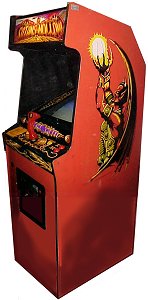

 The Game: You’re on the run from the long arm of the law, and the police radio dispatchers have put an an APB out for you. Money lines the city streets, and you must evade the cop cars and stash away all the cash until the screen is cleared. Four special items in the corners of the screen enable you to turn the table on your pursuers and temporarily eliminate them from the screen – but they’ll be back. If the police cars catch you, you have the right to remain silent; if they catch your last getaway car, you have the right to see “game over” on the screen. (Pacific Novelty, 1981)
The Game: You’re on the run from the long arm of the law, and the police radio dispatchers have put an an APB out for you. Money lines the city streets, and you must evade the cop cars and stash away all the cash until the screen is cleared. Four special items in the corners of the screen enable you to turn the table on your pursuers and temporarily eliminate them from the screen – but they’ll be back. If the police cars catch you, you have the right to remain silent; if they catch your last getaway car, you have the right to see “game over” on the screen. (Pacific Novelty, 1981) The Game: The Martians are coming! And they’re coming in colorful vector graphics! The tripod-like Martian War Machines land, extend their legs, and begin marching inexorably toward your cannon, pausing momentarily to sweep the bottom of the screen with their deadly heat rays, or hurling spirals of energy your way to slow down your cannon. You have a shield that can offer you mere moments of protection, but if it wears out or you find yourself in the Martians’ sights, your spiky-headed cannon operator is fried, and the cannon is promptly manned by another spiky-headed gunner. When your spiky-headed infantry is exhausted, the Martian invasion continues… (Cinematronics, 1981)
The Game: The Martians are coming! And they’re coming in colorful vector graphics! The tripod-like Martian War Machines land, extend their legs, and begin marching inexorably toward your cannon, pausing momentarily to sweep the bottom of the screen with their deadly heat rays, or hurling spirals of energy your way to slow down your cannon. You have a shield that can offer you mere moments of protection, but if it wears out or you find yourself in the Martians’ sights, your spiky-headed cannon operator is fried, and the cannon is promptly manned by another spiky-headed gunner. When your spiky-headed infantry is exhausted, the Martian invasion continues… (Cinematronics, 1981) The Game: An oversized gorilla kidnaps the girlfriend of an unidentified plumber and hauls her up to the top of a building. You are that plumber who shall remain nameless, dodging
The Game: An oversized gorilla kidnaps the girlfriend of an unidentified plumber and hauls her up to the top of a building. You are that plumber who shall remain nameless, dodging 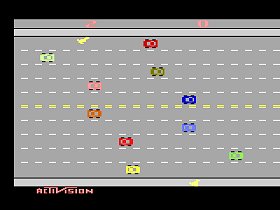 The Game: Why the chicken crossed the road is no longer the question. Now the question is will the chicken cross the road? That part is up to you. You are the chicken. You must avoid traffic, but that’s a real challenge when
The Game: Why the chicken crossed the road is no longer the question. Now the question is will the chicken cross the road? That part is up to you. You are the chicken. You must avoid traffic, but that’s a real challenge when 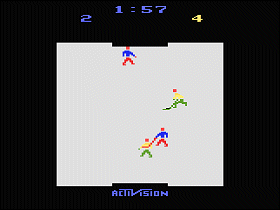
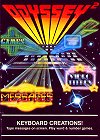 The Game: Well, it’s really not much of a game. It’s more like a home simulation of an early-1980s public access cable channel. You can type up crawls that scroll across the screen, as well as setting an on-screen clock. Events can also be programmed to trigger special messages either at a pre-set time, or at regular intervals. (Magnavox, 1981)
The Game: Well, it’s really not much of a game. It’s more like a home simulation of an early-1980s public access cable channel. You can type up crawls that scroll across the screen, as well as setting an on-screen clock. Events can also be programmed to trigger special messages either at a pre-set time, or at regular intervals. (Magnavox, 1981)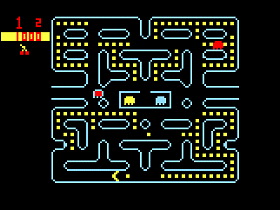 The Game: As a round yellow creature consisting of a mouth and nothing else, you maneuver around a relatively simple maze, gobbling small dots and evading four colorful monsters who can eat you on contact. In four corners of the screen, large flashing dots enable you to turn the tables and eat the monsters for a brief period. Periodically, assorted items appear near the center of the maze, and you can consume these for additional points as well. The monsters, once eaten, return to their home base in ghost form and return to chase you anew. If cleared of dots, the maze refills and the game starts again, but just a little bit faster… (Bally, 1981)
The Game: As a round yellow creature consisting of a mouth and nothing else, you maneuver around a relatively simple maze, gobbling small dots and evading four colorful monsters who can eat you on contact. In four corners of the screen, large flashing dots enable you to turn the tables and eat the monsters for a brief period. Periodically, assorted items appear near the center of the maze, and you can consume these for additional points as well. The monsters, once eaten, return to their home base in ghost form and return to chase you anew. If cleared of dots, the maze refills and the game starts again, but just a little bit faster… (Bally, 1981)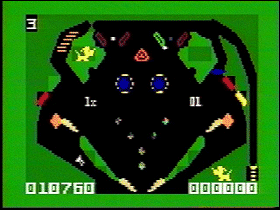
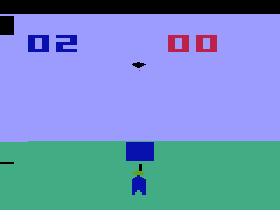 The Game: Line up moving targets in your sights and blast ’em away. The more targets you hit, the more points you get. Simple enough, eh? Just don’t expect everything to travel in a straight line – and keep in mind that something like 80% of the time you won’t have a chance of hitting anything at all due to where you’re positioned. (Games By Apollo, 1981)
The Game: Line up moving targets in your sights and blast ’em away. The more targets you hit, the more points you get. Simple enough, eh? Just don’t expect everything to travel in a straight line – and keep in mind that something like 80% of the time you won’t have a chance of hitting anything at all due to where you’re positioned. (Games By Apollo, 1981) The Game: Piloting a lone spaceship zipping over a planet’s surface in a low, fast orbit, your mission is to kick some evasive alien butt. Drawing a bead on the aliens is much harder than it looks, and they arrive in waves of four. Naturally, it seems like it’s much easier for them to target you… (Games By Apollo, 1981)
The Game: Piloting a lone spaceship zipping over a planet’s surface in a low, fast orbit, your mission is to kick some evasive alien butt. Drawing a bead on the aliens is much harder than it looks, and they arrive in waves of four. Naturally, it seems like it’s much easier for them to target you… (Games By Apollo, 1981) The Game: You’re trapped in a multi-story building with hostile forces all around. Your infiltration mission has gone from mere espionage to a battle for survival – a battle you’re probably not going to win. Board elevators to reach the opposite level of the screen to retrieve enemy secrets, all while avoiding enemy agents and trying to shoot them down. (This spy business would be a lot easier if the enemy couldn’t shoot back, but generally they’re better shots than you are.) Then a new prize appears at the opposite end of the screen, sending you on yet another dangerous mission. (Games By Apollo, 1981)
The Game: You’re trapped in a multi-story building with hostile forces all around. Your infiltration mission has gone from mere espionage to a battle for survival – a battle you’re probably not going to win. Board elevators to reach the opposite level of the screen to retrieve enemy secrets, all while avoiding enemy agents and trying to shoot them down. (This spy business would be a lot easier if the enemy couldn’t shoot back, but generally they’re better shots than you are.) Then a new prize appears at the opposite end of the screen, sending you on yet another dangerous mission. (Games By Apollo, 1981)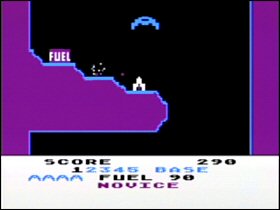 The Game: The enemy in an interplanetary war has gone underground, and you’re piloting the ship that’s taking the fight to him. But he hasn’t just hidden away in a hole; he’s hidden away in a very well-defended hole. As if it wasn’t already going to be enough of a tight squeeze navigating subterranean caverns on Mars, you’re now sharing that space with enemy ships and any number of other fatal obstacles. (Fortunately, the enemy also leaves copious numbers of helpful fuel depots for you too.) Once you fight your way to the bottom of the cave, you plant charges on the enemy mothership – meaning that now you have to escape the caverns again, and fast. (Atari, 1981)
The Game: The enemy in an interplanetary war has gone underground, and you’re piloting the ship that’s taking the fight to him. But he hasn’t just hidden away in a hole; he’s hidden away in a very well-defended hole. As if it wasn’t already going to be enough of a tight squeeze navigating subterranean caverns on Mars, you’re now sharing that space with enemy ships and any number of other fatal obstacles. (Fortunately, the enemy also leaves copious numbers of helpful fuel depots for you too.) Once you fight your way to the bottom of the cave, you plant charges on the enemy mothership – meaning that now you have to escape the caverns again, and fast. (Atari, 1981)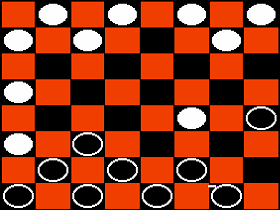 The Game: The classic game of strategy is faithfully reproduced on the Apple II. Two armies of twelve men each advance diagonally across the checkerboard, jumping over opponents and attempting to reach the enemy’s home squares to be crowned. Whoever still has pieces still standing at the end of the game wins. (Odessa Software, 1981)
The Game: The classic game of strategy is faithfully reproduced on the Apple II. Two armies of twelve men each advance diagonally across the checkerboard, jumping over opponents and attempting to reach the enemy’s home squares to be crowned. Whoever still has pieces still standing at the end of the game wins. (Odessa Software, 1981)